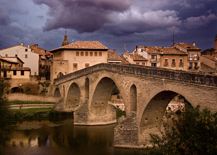
Locality: PUENTE LA REINA (31100)
Zone: The Central Zone
Style: Romanesque
Centuries of construction: XI
The Romanesque bridge of Puente la Reina is one of the most interesting examples of civil architecture on the Pilgrims’ Way to Santiago in Navarre. It marks the convergence of the two routes – the ?Jacobean’ one via Roncesvalles, and the Toulouse-Somport route. It is a meeting point for pilgrims who, over the centuries, have woven thousands of stories and legends. The waters of the river Arga that flow beneath the stunning arcade of the ancient bridge whisper the most amazing stories to travellers, who let themselves be enchanted by their murmuring. You just need to listen carefully and you’ll be able to hear the colourful legend of the txori. The Romanesque bridge gave its name to the town of Puente la Reina (Queen’s Bridge), which is the capital of the Ilzarbe or Valdizarbe valley in the Central Zone of Navarre.
This bridge over the river Arga was built in the 11th century, seemingly at the initiative of a queen, who could well have been Doña Mayor de Castilla, the wife of Sancho el Mayor, or perhaps Lady Stephanie, the wife of García Nájera. The aim of its construction was to make it easier for pilgrims on the Road to Santiago to leave the town after going along the Rúa Mayor (main street).
It is one of the most majestic examples of civil Romanesque architecture on the Pilgrim’s Way. Its most notable features are its elegance and sobriety. It has seven semi-circular arches, the most easterly of which is underground, and is 110 metres long. Between the arches are some smaller arched openings that serve as vent holes, which lighten the structure and allow the water to run through when the river rises. The bridge used to have three defensive towers, one at each end and a central one, which housed the Renaissance image of the Virgin del Puy, also known as the Txori.
There is a legend associated with this Virgin that tells that the image used to be visited by a little bird (“txori” in Basque) which looked after it and groomed it, removing cobwebs with its wings and washing its face with water it collected from the river Arga. It is said that whenever the txori appeared, the bells were set ringing and religious festivals were celebrated.
If you visit the bridge today you will no longer find the image of the Virgin Mary, as it was moved to the church of San Pedro, close to the river, in 1843.
It is well worth visiting this church, which is notable for its altarpieces, as well as the church of Santiago el Mayor, which has a delightful Romanesque portico of Mozarabic influence, and whose interior houses a valuable Gothic image of the apostle Santiago (St. James). The Church of the Crucifix is also interesting, with its two naves, one Romanesque and the other Gothic, whose construction is attributed to the Templars and which contains an interesting Gothic crucifix.
We also recommend a walk around the town, which has preserved all the charm of a town that originated to serve the Pilgrims’ Way to Santiago – you need only see the typical layout of its streets. Puente la Reina grew on both sides of the Pilgrims’ Way, around which two large parallel streets took shape as well as other narrower ones known as belenas.
The two routes known as the ?French Way’ converge in this town: the route via Roncesvalles and the one which, after traversing the Somport mountain pass to the north of Jaca, enters Navarre via the Merindad (historical territory) of Sangüesa.
Other nearby sights of interest include the remains of the Roman town of Andelos in the municipality of Mendigorría, around six kilometres from Puente la Reina; the Cerco de Artajona, a fortified enclave dating from the 11th century, just 8.5 kilometres from Mendigorría, and finally the Romanesque church of Santa María de Eunate in the locality of Muruzábal, 5.5 kilometres from Puente la Reina. The building is notable for its octagonal layout and unusual set of arches.







